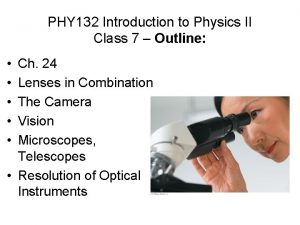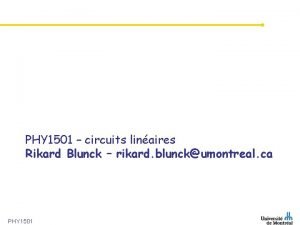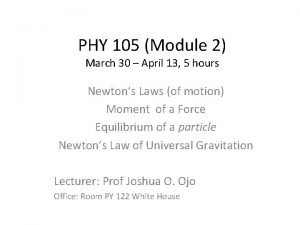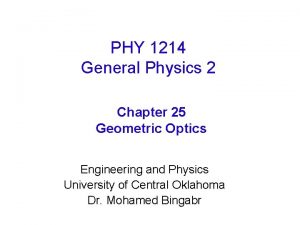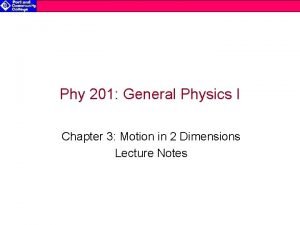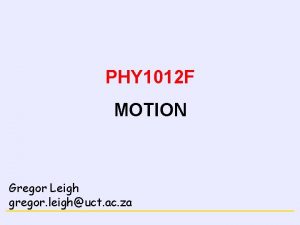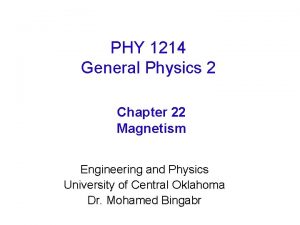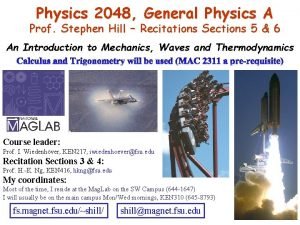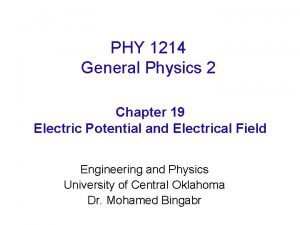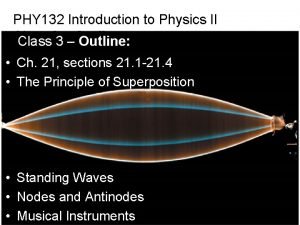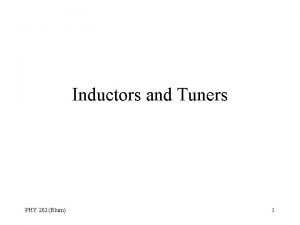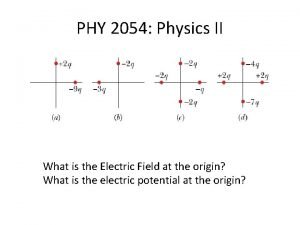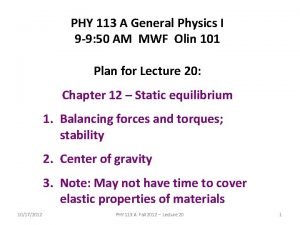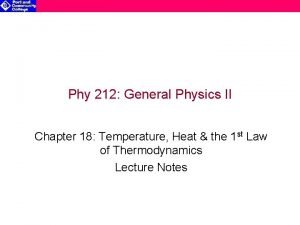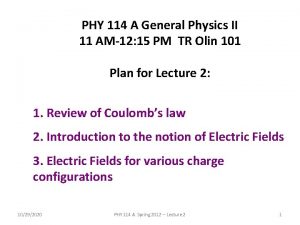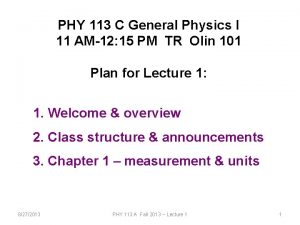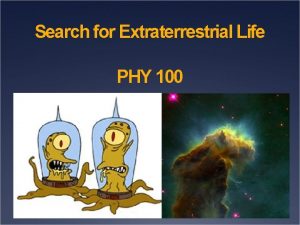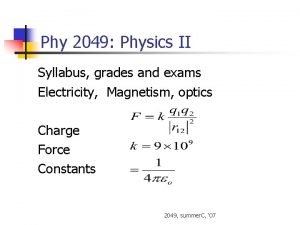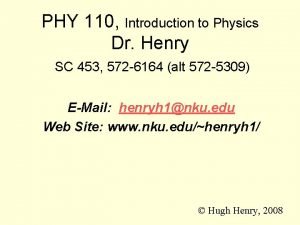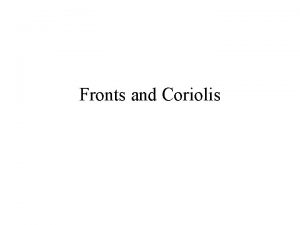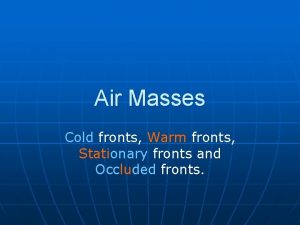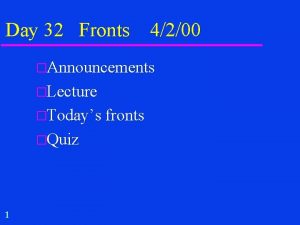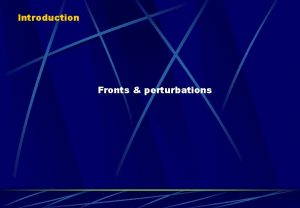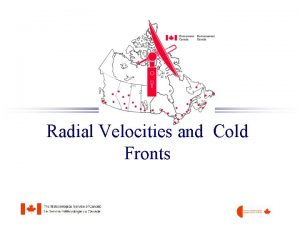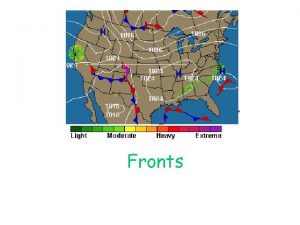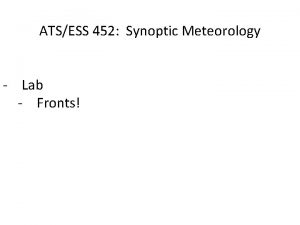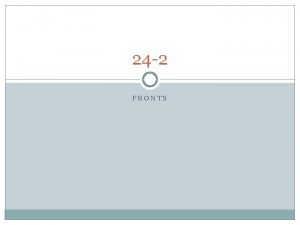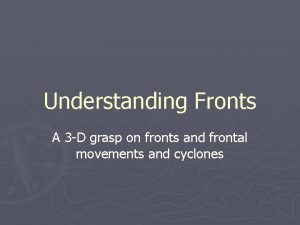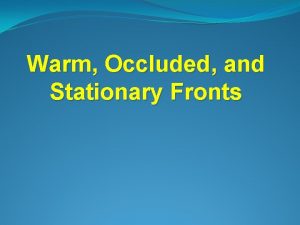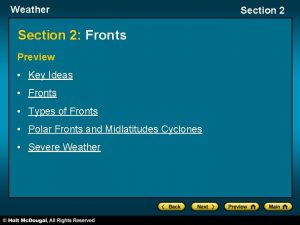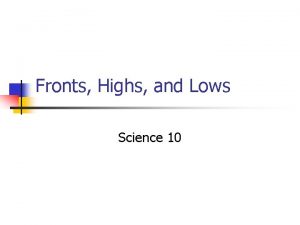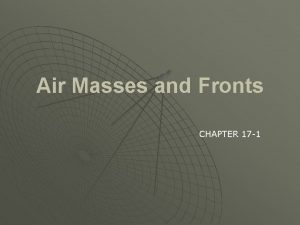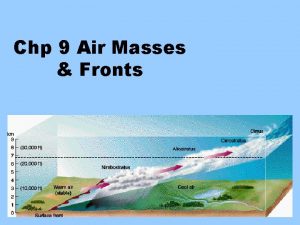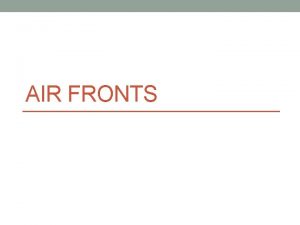PHY 102 Lecture 9 9 1 Wave Fronts



































- Slides: 35

PHY 102: Lecture 9 • 9. 1 Wave Fronts and Rays • 9. 2 Reflection of Light • 9. 3 Spherical Mirrors

PHY 102: Lecture 9 Reflection of Light : Mirrors 9. 1 Wave Front and Rays

Wave Fronts and Rays - 1 • Given a small spherical object whose surface is pulsating in simple harmonic motion • A sound wave is emitted that moves spherically outward from the object at a constant speed • To represent this wave, we draw surfaces through all points of the wave that are in the same phase of motion • These surfaces of constant phase are called wave fronts

Wave Fronts and Rays - 2 • Wave fronts are concentric spherical shells about the vibrating object • If the wave fronts are drawn through the condensations, or crests, of the sound wave, the distance between adjacent wave fronts equals the wavelength • The radial lines pointing outward from the source and perpendicular to the wave fronts are called rays

Wave Fronts and Rays - 3 • Shows small sections of two adjacent spherical wave fronts • At large distances from the source, the wave fronts become less and less curved and approach the shape of flat surfaces

Wave Fronts and Rays - 4 • A wave whose wave fronts are flat surfaces are plane waves

PHY 102: Lecture 9 Reflection of Light : Mirrors 9. 2 Reflection of Light

Geometry of Reflection • A ray of light is incident on a flat, shiny surface • Normal is line perpendicular to surface at point of incidence • The angle of incidence qi is the angle that the incident ray makes with respect to the normal • The angle of reflection qr is the angle that the reflected ray makes with the normal

Law of Reflection • The incident ray, the reflected ray, and the normal to the surface all lie in the same plane • The angle of reflection equals the angle of incidence • r = i

Secular / Diffuse Reflection • When parallel light rays strike a smooth, plane surface, the reflected rays are parallel to each other • This type of reflection is known as specular reflection • Most surfaces are not perfectly smooth, because they contain irregularities the sizes of which are equal to or greater than the wavelength of light • The law of reflections applies to each ray, but the irregular surface reflects the light rays in various directions • This type of reflection is known as diffuse reflection

Formation of Images by a Plane Mirror • Properties of image in a plane (flat) mirror • Image is upright • Image is the same size • Image is located as far behind the mirror as you are in front of it • Image is same color • Image reversed right to left – Letters and words held up to a mirror are reversed

Illustration that Image Appears Behind Plane Mirror - 1 • • (a) A light ray leaves the top of an object This ray reflects from the mirror and enters the eye To the eye, it appears that the ray originates from behind the mirror back along the dashed line • Actually, rays going in all direction leave each point on the object, but only a small bundle of such rays is intercepted by the eye

Illustration that Image Appears Behind Plane Mirror • (b) • The figure shows a bundle of two rays leaving the top of the object • All the rays that leave a given point on the object, no matter what the angle they have when they strike the mirror, appear to originate from a corresponding point on the image behind the mirror

Virtual / Real Images • Rays of light seem to come from the image • It is evident that they do not originate from behind the plane mirror where the image appears to be • Because none of the light rays actually emanate from the image, it is called a virtual image • Curved mirrors can produce images from which all the light rays actually do emanate • Such images are known as real images

Half Height Mirror • What is the minimum mirror height necessary to see full body? • Conclusion valid regardless of distance of person from mirror • To view one’s full length in a mirror, only a half-length mirror is needed • ½ mirror must face upper body

PHY 102: Lecture 9 Reflection of Light : Mirrors 9. 3 Spherical Mirrors

Convex / Concave Mirrors - 1 • The most common type of curved mirror is a spherical mirror • A spherical mirror has the shape of a section from the surface of a sphere • If the inside surface of the mirror is polished, it is a concave mirror • If the outside surface is polished, it is a convex mirror

Convex / Concave Mirrors - 2 • For each type mirror, the center of curvature is located at point C • Radius of curvature is R • The principal axis of the mirror is a straight line drawn through C and the midpoint of the mirror

Operation of Concave Mirror - 1 • A point on the tree lies on the principal axis of the mirror and is beyond the center of curvature C • Light rays emanate from this point and reflect from the mirror consistent with the law of reflection • If the rays are near the principal axis, they cross it at a common point after reflection • This point is called the image point • Since light rays come from the image point, the image is real

Operation of Concave Mirror - 2 • If tree is infinitely far away from mirror, the rays are parallel to each other and to the principal axis • Rays reflect from the mirror and pass through an image point • In this special case the image point is referred to as the focal point F of the mirror • Therefore, an object infinitely far away on the principal axis gives rise to an image at the focal point of the mirror • The distance between the focal point and the middle of the mirror is the focal length f of the mirror

Location of Focal Point F Concave Mirror • Focal point F lies halfway between the center of curvature C and the middle of a concave mirror • Focal length f equal one-half the radius of curvature • f=½R

When is “f = ½R” Valid • Rays that lie close to the principal axis are paraxial rays • f = ½ R is valid only for such rays • Rays that are far from the principal axis do not converge to a single point after reflection from the mirror • The result is a blurred image • The fact that a spherical mirror does not bring all rays parallel to the principal axis to a single image point is spherical aberration • Spherical aberration can be minimized by using a mirror whose height is small compared to the radius of curvature

Location of Focal Point F Convex Mirror • Parallel, paraxial rays are incident on a convex mirror • The rays diverge after being reflected • The reflected rays seem to come from a single point F behind the mirror • This point is the focal point of the convex mirror • Its distance from the midpoint of the mirror is the focal length f • The focal length of a convex mirror is also ½ of the radius of curvature • We assign the focal length of a convex mirror a negative value • f = -½ R

Formation of Images - Concave • Ray 1: Ray is initially parallel to the principal axis • Passes through the focal point F after reflecting from the mirror. • Ray 2: Ray initially passes through the focal point F • Is reflected parallel to the principal axis. • Ray 3: Ray travels along a line that passes through the center of curvature C and follows a radius of the spherical mirror • Ray strikes the mirror perpendicularly and reflects back on itself

Formation of Images - Concave

Formation of Images - Concave

Concave Mirror Chart Object Image Location Image Size Upright Inverted Real Virtual >2 f (C) >f Small Inverted Real = 2 f (C) 2 f Same Inverted Real 2 f(C) to f >2 f Larger Inverted Real =f Infinity - - - <f - Larger Upright Virtual

Convex Mirror Chart Object Image Location Any where - Image Size Upright Inverted Real Virtual Smaller Upright Virtual Convex mirror gives wider field of view than other types of mirrors

Formation of Images - Convex • Ray 1: Ray is initially parallel to the principal axis • Appears to originate from the focal point F after reflection from the mirror • Ray 2: Ray heads toward F • Emerges parallel to the principal axis after reflection • Ray 3: Ray travels toward the center of curvature C • Ray strikes the mirror perpendicularly and reflects back on itself

Mirror Equation - Distance do is distance of object from mirror di is distance of image from mirror f is focal length - for diverging (convex) mirror + for converging (concave) mirror

Example Mirror Equation - Distance Focal length of concave mirror is f = + 4 cm Object is located at do = 10 cm What is location of image, di? (1/10) + (1/di) = +¼ 0. 10 + (1/di) = 0. 25 1/di = 0. 25 – 0. 10 = 0. 15 di = 1/0. 15 = 6. 67 cm Positive image distance means image is “real”

Example Mirror Equation - Distance Focal length of convex mirror is f = - 4 cm Object is located at do = 10 cm What is location of image, di? (1/10) + (1/di) = -¼ 0. 10 + (1/di) = -0. 25 1/di = -0. 25 – 0. 10 = -0. 35 di = -1/0. 35 = -2. 87 cm Negative image distance means image is “virtual”

Mirror Equation – Size or Magnification • magnification = Positive magnification means upright image Negative magnification means inverted image

Example Magnification Equation Focal length of concave lens is f = + 4 cm Object is located at do = 10 cm Image is located at di = 6. 67 cm Magnification = - 6. 67 / 10 = - 0. 67 The image is inverted and smaller

Example Magnification Equation Focal length of convex lens is f = - 4 cm Object is located at do = 10 cm Image is located at di = -2. 87 cm Magnification = - (-2. 87) / 10 = + 0. 29 The image is upright and smaller
 North american air masses
North american air masses What is farsightedness called
What is farsightedness called 01:640:244 lecture notes - lecture 15: plat, idah, farad
01:640:244 lecture notes - lecture 15: plat, idah, farad Phy circuit
Phy circuit Phy113
Phy113 Phy-105 5 discussion
Phy-105 5 discussion Real image
Real image Vx=vox+axt
Vx=vox+axt Site:slidetodoc.com
Site:slidetodoc.com Phy theorem
Phy theorem Phy
Phy Atm basics
Atm basics Phy tgen
Phy tgen General physics
General physics Phy 121 asu
Phy 121 asu Stephen hill fsu
Stephen hill fsu Phy 1214
Phy 1214 Phy 2049
Phy 2049 Phy 132
Phy 132 Rotational statics
Rotational statics Felix connects a wire coil to an ammeter
Felix connects a wire coil to an ammeter Fizik ii
Fizik ii 2012 phy
2012 phy Ddr phy architecture
Ddr phy architecture Examples of convection
Examples of convection Phy
Phy Phy 131 past papers
Phy 131 past papers Phy
Phy Phy
Phy Phy 1214
Phy 1214 Life phy
Life phy Phy theorem
Phy theorem Phy 2049
Phy 2049 Phy 205
Phy 205 General physics 1 measurements
General physics 1 measurements Phy 110
Phy 110

